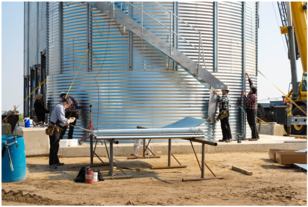Hutterite Colonies - Traditional Values meet State of the Art Farming
Posted on
Traditional Values meet State of the Art Farming
A desire to live free from religious persecution and a dedication to their traditional way of life are the underlying values that have allowed the Hutterite people of Alberta to thrive and become among the most technically advanced farmers in Canada.
Originating from the Anabaptist movement in 16th-century Europe, founded by Jakob Hutter and his followers, the communal movement sought refuge in various regions of Europe. Eventually, they migrated to North America in the late 19th century for religious freedom and economic opportunities. Initially settling in South Dakota, some Hutterites moved to Canada to maintain their communal lifestyle. The availability of fertile land and the promise of religious freedom drew them to the Canadian Prairies. Today, Hutterite colonies can be found in a number of Canadian provinces.
While their clothing may reflect traditional styles, the Hutterite communities have embraced modern agricultural practices. Their farming equipment is state of the art, making them highly efficient and productive. Hutterites are responsible for a significant portion of Alberta's agricultural output. They produce 80% of the eggs, 40% of the pork, 25% of the milk, and 20% of the poultry in the province. The hallmark of Hutterite life is their communal living arrangement. While each family has its own living space, daily meals are prepared in a central kitchen and shared together, fostering a sense of unity and togetherness.
Founded in 1955, the Springside Colony, located 25km northeast of Brooks along the Red Deer River, is one of 7 colonies with their home farm in the Brooks Newell Region. With a population of around 160 people, their communal lifestyle is sustained through a shared effort of work, childcare, household duties, and elder care. The colony has its own school, church, feed mill, cement plant, butchery, commercial laundry and kitchen, along with a wide variety of equipment and facilities that allows it to maintain a level of self-sufficiency that is unique.
The Hutterite community is resistant to the acceptance of technology and personal goods common in the modern world, such as cell phones, electronic entertainment, or personal vehicles, yet they are very willing to adopt the best technology available to advance their farming practices. Some colonies have diversified their operations outside of the typical agricultural realm however, Springside remains focused on the more traditional farm sectors. They rely on their 24,000 laying hens, 350 head of cattle, turkey and pig operations to fill their days. Combine that with the variety of crops they grow on approximately 14,600 acres (5900 hectares) of land, of which around 6,500 acres (2600 hectares) is irrigated, the Springside Colony benefits greatly from an economy of scale that, like most Hutterite colonies, makes them a financially successful operation.
While they are protective of their traditional lifestyle, given the proper courtesy, Hutterite Communities are open and friendly to visitors who are interested in learning more about their farming practices and way of life.

